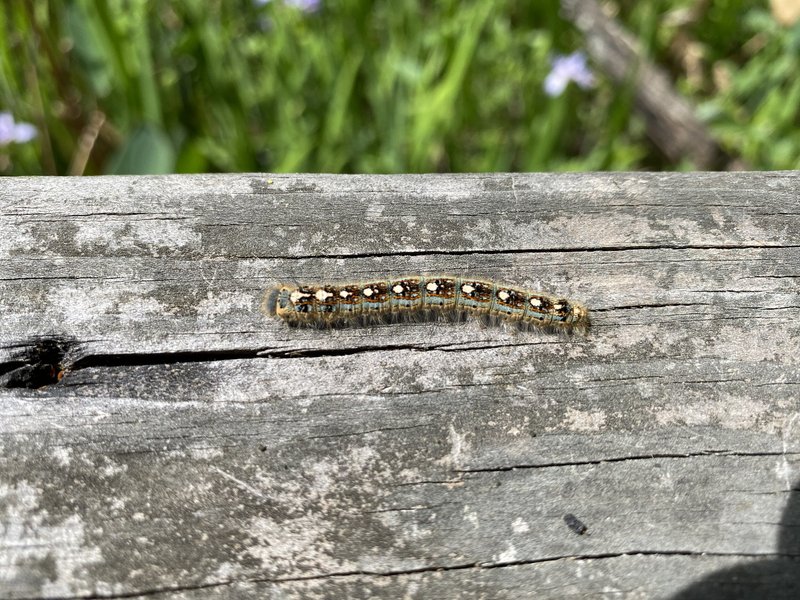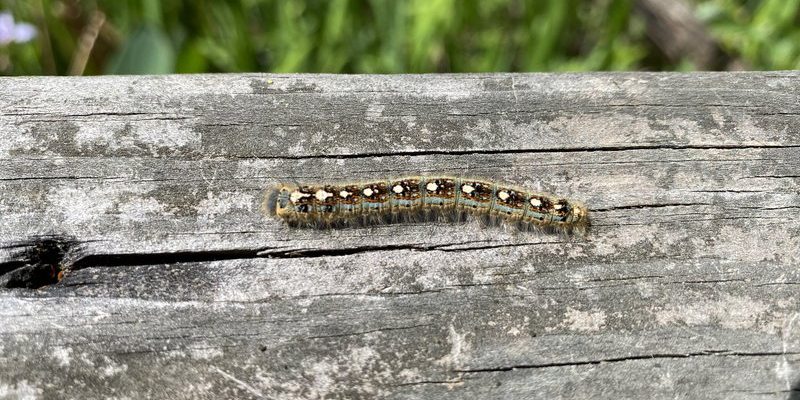
Have you ever come across a cluster of fuzzy caterpillars munching on the leaves of a tree? If so, you likely encountered the Forest Tent Caterpillar. These fascinating little creatures can be both a wonder and a nuisance in the wild. They’re not your typical caterpillars; instead, they play a unique role in their ecosystem. Understanding their life cycle, behavior, and impact can help you appreciate them—or at least tolerate their presence in your backyard.
The Forest Tent Caterpillar is known for its striking appearance and the chaotic way they move together. Imagine a bunch of friends huddled to avoid the rain—that’s pretty much what these caterpillars do when they form their tents. They may seem cute at first, but don’t let their fluffy exteriors fool you; they can damage trees and crops if their populations explode. Let’s dive deep into the world of these curious crawlers!
What are Forest Tent Caterpillars?
The Forest Tent Caterpillar, scientifically known as Malacosoma disstria, is a species of moth in the family Lasiocampidae. Unlike many other caterpillars, they don’t spin cocoons but instead form silken tents in the branches of trees. These tents serve as a protective shelter where they gather together for warmth and safety while they feed.
You might be wondering how to identify them. Usually, they are characterized by a pale blue or white stripe down their back, along with several other wavy lines. They can grow to about 2.5 inches long and are covered in fine hairs that give them a fuzzy appearance. Their distinctive features make them relatively easy to spot in the wild.
Life Cycle of Forest Tent Caterpillars
The life cycle of the Forest Tent Caterpillar is fascinating and follows a classic pattern found in many moths and butterflies. It begins in the spring, after the caterpillars have overwintered as eggs. As the weather warms, the eggs hatch, and the tiny caterpillars emerge, ready to eat their way through the leaves of deciduous trees.
As they feed, they grow rapidly and shed their skin several times—a process called molting. This growth phase lasts a few weeks. Eventually, they reach maturity and start constructing those characteristic silken tents. As summer approaches, they’re not just growing; they’re also looking for a place to pupate. This is when they transform into the beautiful moths that will eventually emerge as adults.
Once they pupate, they spend some time in their cocoons before emerging as moths, ready to lay the next generation of eggs. It’s a cycle that continues year after year, driven by the changing seasons and the availability of food sources in their environment.
Habitat and Range
You can find the Forest Tent Caterpillar across North America, particularly in areas with plenty of hardwood trees like oaks, maples, and birches. Their habitat preferences are directly linked to their diet, which primarily consists of the leaves from these trees. If you’ve got a healthy stand of deciduous trees nearby, there’s a good chance you might spot these caterpillars at certain times of the year.
These caterpillars thrive in areas where they can access sunlight, which helps them stay warm and active. You might see them during the day, either munching on leaves or hanging out in their tents. This timing can be advantageous, as it helps them avoid some predators that are active at night.
Diet of Forest Tent Caterpillars
When it comes to food, Forest Tent Caterpillars are primarily herbivores. They have a taste for various hardwood trees, but they particularly favor species like aspen, birch, and sweetgum. You might think they’re picky eaters, but they’re quite adaptable and can thrive in different environments.
As they munch on leaves, they can consume large amounts of foliage, which can sometimes lead to tree defoliation. While this isn’t usually fatal for the trees, it may weaken them and make them more susceptible to diseases and pests. So, while they may look harmless, their feeding habits can have a significant impact on local ecosystems.
Impact on Ecosystem and Economy
Forest Tent Caterpillars can have a double-edged sword effect. On one hand, their feeding helps control the growth of certain trees, allowing for a diverse range of plant species to thrive. On the other hand, when their populations explode, they can cause significant defoliation, leading to economic losses in forestry and agriculture.
During outbreak years, these caterpillars can strip trees bare, impacting local wildlife that relies on those trees for habitat and food. They can also cause aesthetic damage to urban trees, which may lead to concerns among homeowners and city planners.
To mitigate the impact of these caterpillars, many forestry services monitor their populations closely. They might implement control measures, like introducing natural predators or using biological controls, to balance their presence in the ecosystem without wreaking havoc.
Predators and Natural Threats
Forest Tent Caterpillars have their fair share of enemies. Birds, wasps, and other insects see them as prime snacks, while larger mammals like squirrels may also take advantage of them. This natural predation helps keep the caterpillar population in check, preventing them from becoming overwhelming.
Interestingly, some birds have adapted particular feeding habits just to take advantage of these caterpillars during their peak seasons. It’s a classic case of nature’s balance, where one species thrives while others depend on them for survival. The silk tents they create can also be a double-edged sword—offering protection from some predators while making them easier targets for others who can find and access them.
Climate factors also play a role in their survival. Periods of heavy rain or extreme temperatures can affect their growth and reproduction rates, ensuring that not every caterpillar survives to adulthood. This is a crucial aspect of their life cycle that helps manage their populations naturally.
Fascinating Facts about Forest Tent Caterpillars
| Scientific Name | Malacosoma disstria |
| Size | Up to 2.5 inches long |
| Habitat | Deciduous forests in North America |
| Diet | Leaves of hardwood trees |
| Lifespan | 1 year |
| Coloration | Pale blue with a distinctive line pattern |
| Population Control | Monitored by natural predators and environmental factors |
Caring for Your Garden: What to Do if You Encounter Them
If you spot Forest Tent Caterpillars in your garden or yard, you might be torn between wanting to protect the environment and preserving your plants. Here’s the thing: a small number of caterpillars won’t do much harm. However, if you notice a large population, you may want to take action to protect your trees.
Handpicking them can be effective, but you should wear gloves to avoid their irritants. Alternatively, consider using a spray of soapy water, which can help deter them. If you prefer to go the organic route, introducing natural predators, like birds, can help maintain balance in your garden.
Remember, it’s all about balance. These caterpillars play a role in the ecosystem, and while they can cause damage, they also support a variety of wildlife. Managing their presence thoughtfully can help you maintain both your garden and the local ecosystem.
The Forest Tent Caterpillar might seem like a small player in the grand scheme of nature, but their presence can have a big impact. They remind us that even the tiniest creatures have their roles in the ecosystem, affecting everything from tree health to the populations of their predators. Whether you’re an avid gardener or simply a curious observer of nature, understanding these caterpillars can enhance your appreciation for the delicate balance of life around us.
FAQ
What is the primary role of Forest Tent Caterpillars in their ecosystem?
Forest Tent Caterpillars serve as both herbivores and prey in their ecosystem. They help control the growth of certain tree species by eating their leaves, allowing for more biodiversity. On the flip side, they provide a food source for various predators, including birds and insects, helping to support the local food chain.
How can I identify Forest Tent Caterpillars?
You can identify Forest Tent Caterpillars by their distinctive appearances. They typically have a blue or white stripe running down their back, along with several wavy lines. They are fuzzy and can grow up to 2.5 inches long. Look for them in clusters on the branches of hardwood trees, often near their silk tents.
Are Forest Tent Caterpillars harmful to trees?
While Forest Tent Caterpillars can cause defoliation, which may weaken trees, they don’t usually kill them outright. However, if their populations are high, they can significantly impact tree health, making them more susceptible to other pests and diseases.
What should I do if I find them in my garden?
If you find Forest Tent Caterpillars in your garden, handpicking them can be a direct way to reduce their numbers. Alternatively, you can use soapy water sprays to deter them or introduce natural predators like birds. It’s important to strike a balance and not eliminate them entirely since they play a role in the ecosystem.
How long do Forest Tent Caterpillars live?
The lifespan of a Forest Tent Caterpillar is generally one year. They undergo various stages throughout their life cycle, including egg, larval (caterpillar), and pupal stages, before emerging as adult moths. The timing and duration of each stage can vary based on environmental factors.
When do Forest Tent Caterpillars typically appear?
Forest Tent Caterpillars usually emerge in spring, right around the time when deciduous trees begin to leaf out. Their visibility peaks in early summer, when they are most active and feeding heavily on leaves. It’s during this time that you might notice their tents in trees.
Are Forest Tent Caterpillars invasive?
In general, Forest Tent Caterpillars are native to North America and are not considered invasive. They have natural predators and are part of the local ecosystem. However, during outbreak years, their populations can explode, leading to significant tree damage, which can create concern among homeowners and forest managers.
Can Forest Tent Caterpillars be beneficial?
Yes, they can be beneficial! By feeding on tree leaves, they help prevent any single species from dominating a forest, thus promoting biodiversity. Additionally, they support food webs as their presence provides nourishment for various birds and other animals.
What do Forest Tent Caterpillars turn into?
Forest Tent Caterpillars eventually metamorphose into moths. After going through their larval stages, they pupate and emerge as adult moths, which will then lay eggs and continue the life cycle. The adult moths are typically active at night and can be seen flying around lights.
Do they bite or sting?
Forest Tent Caterpillars do not bite or sting humans. However, their hair can sometimes cause skin irritation or allergic reactions in sensitive individuals. It’s always best to handle them carefully or use gloves if you need to manage them directly.
How do weather conditions affect Forest Tent Caterpillars?
Weather conditions play a significant role in the life cycle and population dynamics of Forest Tent Caterpillars. Extreme temperatures, heavy rain, or drought can impact their growth, reproduction, and survival rates, ensuring a natural balance in their populations.
What are the signs of a Forest Tent Caterpillar infestation?
Signs of a Forest Tent Caterpillar infestation include visible tents in trees, significant leaf loss, or clusters of caterpillars on branches. If you notice these signs in large numbers, it may be time to take action to protect your plants.

